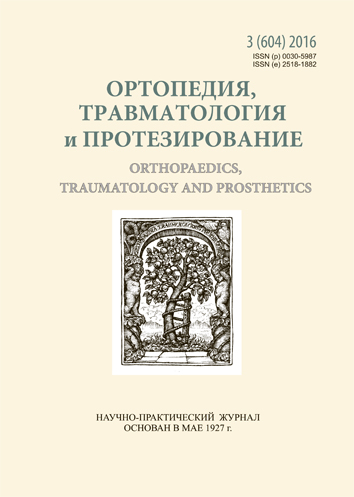Volume ratio of spinal canal and its contents in patients with congenital kyphosis
DOI:
https://doi.org/10.15674/0030-59872016322-26Keywords:
congenital kyphosis, vertebromedular conflict, myelopathy, giant F-vavesAbstract
Congenital anomalies of the spine combine formation and segmentation failures, resulting into asymmetrical and altered growth and kyphotic or kyphoscoliotic deformations that progressing during all the life with the following neurological disturbances. There is no consensus today on the main indications for the surgical treatment.
Objective: To study the volume ratios of the spinal canal and its contents in patients with congenital kyphosis (CK) before surgery and to compare the findings with the clinical neurological manifestations.
Methods: A retrospective analysis of medical records, the results of computer (CT) and magnetresonance tomography (MRI) of 15 patients (3 to 20 years) with the CK who received surgical treatment. All the patients were taken about the clinical, radiological, electroneuromyographic (EMG) examination and MRI.
Results: vertebromedular (VMC) conflict based on MRI data diagnosed in all patients: I degree — in 6, II — in 8, IV — at 1. As a result of electroneuromyographic studies in patient with an IV degree of VMC revealed severe axonal damage of peroneal and tibial nerves. In the group with grade II VMC in 3 patients decreased motor potential and the conduction of the tibial nerve, and 4 has a violation of conduction and synchronization of motor neurons. Such disorders also detected in 4 of 10 patients with VMC degree I and II, but without evidence of neurological deficit.
Conclusion: all patients with CK had failures and VMC varying degrees independently of clinical manifestations of spinal cord compression.Using ENMG in patients with I and II degree of VMC, it is identified violation of motoneuron function and decreased motor conduction in peripheral nerves even without motor and sensory disorders. Indicator of VMC may be informative for predicting the neurological complications, so that all patients with CK CT and MRI studies are indicated.References
- McMaster MJ, Singh H. The surgical management of congenital kyphosis and kyphoscoliosis. Spine. 2001;26(19):2146-54.
- Winter RB, Moe JH, Lonstein JE. The surgical treatment of congenital kyphosis. A review of 94 patients age 5 years or older, with 2 years or more follow-up in 77 patients. Spine. 1985;10: 224-31.
- Suk SI, Kim JH, Kim WJ, Lee SM, Chung ER, Nah KH. Posterior vertebral column resection for severe spinal deformities. Spine. 2002;27(21): 2374-82.
- Bollini G, Docquier PL, Viehweger E, Launay F, Jouve JL. Thoracolumbar hemivertebrae resection by double approach in a single procedure long-term follow-up. Spine. 2006;31(15): 1745-57.
- Lavrukov AM, Tomilov AB. Osteosynthesis using device for external fixation in patients with injury and spine pathology. Yekaterinburg, 2002. 207 p.
- Nikolaev SG. Atlas of electromyography. 2010. 780 p.
- Pan H, Jian F, Lin J, Chen N, Zhang C, Zhang Z, Ding Z, Wang Y, Cui L, Kimura J. F-wave latencies in patients with diabetes mellitus. Muscle Nerve. 2014;49(6):804-8. doi: 10.1002/mus.24127.
- Bal S, Celiker R, Palaoglu S, Cila A. F wave studies of neurogenic intermittent claudication in lumbar spinal stenosis. Am J Phys Med Rehabil. 2006;85(2):135-40.
- Adamova B, Vohanka S, Dusek L. Dynamic electrophysiological examination in patients with lumbar spinal stenosis: is it useful in clinical practice? Eur Spine J 2005;14(3):269-76.
- Adamova B, Vohanka S, Dusek L. Differential diagnostics in patients with mild lumbar spinal stenosis: the contributions and limits of various tests. Eur Spine J 2003;12(2):190-6.
- Funaba M, Kanchiku T, Imajo Y, Suzuki H, Yoshida Y, Nishida N, Fujimoto K, Taguchi T. Characteristics of C 6–7 myelopathy: assessment of clinical symptoms and electrophysiological findings. Spinal Cord. 2015. doi: 10.1038/sc.2015.203.
- Koarashi M. The clinical significance of the F-wave of upper limb on cervicalmyelopathy. Nihon Seikeigeka Gakkai Zasshi. 1983;57(2):123-35.
- Fang J, Cui LY, Liu MS, et al. F wave study in amyotrophic lateral sclerosis: assessment of segmental motoneuronal dysfunction. Chin Med J (Engl). 2015;128(13):1738-42. doi: 10.4103/0366-6999.159346.
- Chroni E, Tendero IS, Punga AR, Stalberg E. Usefulness of assessing repeater F-waves in routine studies. Muscle Nerve. 2012;45(4):477-85. doi: 10.1002/mus.22333.
- Lomaga IA. Neurologic syndromes in children with scoliosis. Synopsis of PhD thesis. Moscow, 2009.
- Magerl F, Aebi M, Gertzbein SD, Harms J. A comprehensive classification of thoracic and lumbar injuries. Eur. Spine Journal. 1994;3(4):184-201.
- O. Keynan, C. G. Fisher, A. Vaccaro [et al. Radiographic measurement parameters in thoracolumbar fractures: a systematic review and consensus statement of the spine trauma study group. Spine. 2006;31(5):E156–E165.
Downloads
How to Cite
Issue
Section
License
Copyright (c) 2016 Andrey Mezentsev, Dmytro Petrenko, Dmytro Demchenko, Diana Dupliy

This work is licensed under a Creative Commons Attribution 4.0 International License.
The authors retain the right of authorship of their manuscript and pass the journal the right of the first publication of this article, which automatically become available from the date of publication under the terms of Creative Commons Attribution License, which allows others to freely distribute the published manuscript with mandatory linking to authors of the original research and the first publication of this one in this journal.
Authors have the right to enter into a separate supplemental agreement on the additional non-exclusive distribution of manuscript in the form in which it was published by the journal (i.e. to put work in electronic storage of an institution or publish as a part of the book) while maintaining the reference to the first publication of the manuscript in this journal.
The editorial policy of the journal allows authors and encourages manuscript accommodation online (i.e. in storage of an institution or on the personal websites) as before submission of the manuscript to the editorial office, and during its editorial processing because it contributes to productive scientific discussion and positively affects the efficiency and dynamics of the published manuscript citation (see The Effect of Open Access).














